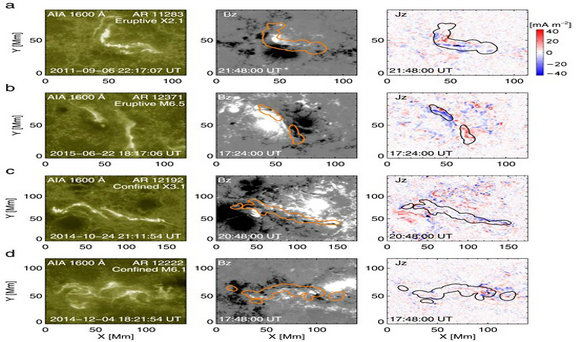New Parameter Determining Solar Eruptions
In our solar system, solar flares and coronal mass ejections (CME) are the most spectacular eruptive activities. Large solar flares and CMEs could bring us disastrous space weather, destroy our satellite and navigation system, and cause a large-scale blackout on the Earth.
Solar activity sometimes stays trapped close to the Sun's surface - but sometimes it breaks free in enormous ejections of hot plasma. What determines whether a solar flare stays confined or is followed by a catastrophic eruption?
A new study led by Dr. Ting Li from the National Astronomical Observatories of the Chinese Academy of Sciences (NAOC) reveals the clues. The results have been published on The Astrophysical Journal Letters this February.
The researchers explored the magnetic parameters of the active region (AR) where a flare originates. They analyzed 106 large flares from the satellite of Solar Dynamics Observatory (SDO) observed during 2010-2019. The statistical results showed that the relative measure of magnetic nonpotentiality within the AR core over the restriction of the background field is well able to distinguish two types of solar flares.
Magnetic nonpotentiality reflects the degree that the magnetic fields deviate from the potential fields (see Figure). The larger the magnetic nonpotentiality of ARs is, the more likely the AR produces eruptions. The restriction of the background field can be calculated with the parameter of total unsigned magnetic flux of ARs.
The results revealed that the new relative magnetic parameter largely controls the capability of ARs to produce eruptive flares associated with CMEs. The new parameter has important implications for the prediction of CMEs occurring in association with large flares.
In future, the new parameter can be used to develop a high-accuracy predictive model for CMEs. The prediction of CMEs is very important for human beings, as the CMEs are the dominant contributors to adverse space weather on Earth.
This work was a collaboration with China Meteorological Administration, the School of Physics and Materials Science at Anhui University, and the Institute for Astronomy at University of Hawaii.

Figure: Left column: flare ribbons; middle column: magnetic fields of ARs; right column: distributions of magnetic nonpotentiality. (Credit: Ting Li)
This paper can be accessed at https://iopscience.iop.org/article/10.3847/2041-8213/ac5251